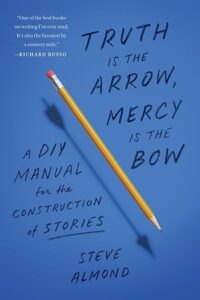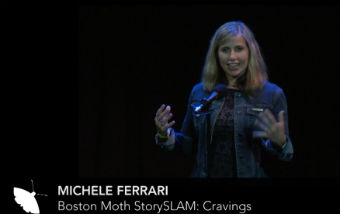 Anyone who’s ever had the pleasure of taking a class with Steve Almond, read his novel All the Secrets in the World, or gobbled up Dear Sugars for that matter, knows that Almond practices what he describes as radical empathy. As a teacher and writer he’s interested in nothing less than getting at the essential meaning of things—and he’ll happily tear down any of the so-called rules we’ve all been taught to do it. But where his new book, Truth is the Arrow, Mercy is the Bow: A DIY Manual for the Construction of Stories (Zando), shines is in showing us how we writers get in our own way. You know what I’m talking about: Those moments when ego gets the best of us or we pull back because we’re afraid of failure or how the truth might break our mothers’ hearts. Worse, yet: how being so honest makes us feel naked on the page.
Anyone who’s ever had the pleasure of taking a class with Steve Almond, read his novel All the Secrets in the World, or gobbled up Dear Sugars for that matter, knows that Almond practices what he describes as radical empathy. As a teacher and writer he’s interested in nothing less than getting at the essential meaning of things—and he’ll happily tear down any of the so-called rules we’ve all been taught to do it. But where his new book, Truth is the Arrow, Mercy is the Bow: A DIY Manual for the Construction of Stories (Zando), shines is in showing us how we writers get in our own way. You know what I’m talking about: Those moments when ego gets the best of us or we pull back because we’re afraid of failure or how the truth might break our mothers’ hearts. Worse, yet: how being so honest makes us feel naked on the page.
Writerly bravery is a tall order and it’s not a skillset that can be taught, though it can be nurtured, which is precisely what Almond counsels us to do in his new book. Truth is the Arrow, Mercy is the Bow is not your average craft book (though Almond includes a few prompts) but rather a writer’s guide to being in the world, offering incomparable insights into the storyteller’s project from a practitioner who’ll be the first to admit he’s earned his wisdom the hard way.
Nicole Vecchiotti: I know some of these essays were written over the years, but why this craft book now?
Steve Almond: Thank you for that generous description of the book. It makes my heart sing. Because I don’t really view Truth as a traditional craft book. As you say, it’s about the author’s project, the whole creative process. And really, that’s not just about figuring out the elements of craft. It’s also about where stories come from (inspiration) and the stuff that haunts us, and holds us back, at the keyboard. I’ve been writing it—in my head, in the classroom, and at various writing conferences—for three decades. I decided to compile it all into a book now, I guess, because I felt I’d finally figured out the novel form, which, for me, is the most challenging one, and required a deeper engagement with the process. So I guess I finally felt “qualified.” I was also eager to share my ideas, and my philosophy, with a wider audience than the folks I might teach in a class.
NV: The elements of craft you’ve chosen to highlight in Part One interest me (plot, character, chronology, openings and narration). I’m sure you could’ve included others—point of view, setting, etc., but what is it about these five concepts that make them so essential to the construction of stories?
SA: It’s sort of an “order of operations” thing for me. Setting and POV and so forth are important, but the elements above are fundamental. The building blocks of story. Until you get a handle on plot, or character, or narrative stance, you’re kind of driving blind. Or at least, that’s how it felt to me. These are also the topics about which I find myself yammering most consistently to students.
NV: Part One of the book is fantastic, but what really bowled me over was Parts Two (Source Material) and Three (Meditations), where you’re really encouraging students to be more contemplative, generous and honest humans—which is the heart and soul of the book. Essentially, you’re saying you must be authentic on the page all the time. Good writers know when they’re being inauthentic, but I’m wondering if you can say a little about how readers sniff it out—because I agree with you, I think they can and will.
SA: Yeah, the reader wants a story. They want to identify and empathize with the characters, and they want the plot to press those characters up against their fears and desires. Any time the writer steps between the reader and the characters—with ornamental language, for instance, or by suddenly auditioning a new plot element—the reader falls out of the story. They sense that the writer has begun to perform, rather than storytelling.
NV: I’d love to drill down on the ways you encourage students to transfer that examined humanity onto the page. You write: “We need to stop protecting our characters (and ourselves) from the very thing our reader has arrived most eager to experience: uncontrollable emotions.” Can you say a little about why writers are too nice to their characters?
SA: In our civilian lives, off the page, we’re constantly seeking the emotional safety of stability, equilibrium, avoidance. And that makes sense. We don’t to lead lives of unremitting emotional intensity. But as readers, we come to story for the opposite reason. We want to know that other human beings are dealing with the intense, out-of-control feelings that they spend so much time suppressing. As writers, we have to be willing to go against our instincts—to put our characters in the emotional dangers we dodge.
NV: You discuss the difference between interiority (seeing the world through the character’s eyes) with intimacy, arguing that intimacy is what delivers truly round characters, and advise that “the pleasure of storytelling is that the author boils away all the fruitless session work and delivers only the vital moments of transformation and self-revelation.” In other words, you cut all the getting-to-know-you scenes and get to the meat of things. Or in other-other-words, you’re seeking the moments when the character’s actions are most relatable to us as readers—even when/especially when they are doing something that highlights a conflict within themselves. In your writing practice, what type of character work do you do to gain that intimacy?
SA: I do think those “getting to know you” scenes are a necessary part of the process. I find that I often have to spend time with characters, before they fully reveal who they are. To give a concrete example: it took me several drafts before I fully understood Lorena Saenz, the teenage protagonist of All the Secrets of the World. I knew she wanted to be seen and understood. But there came a moment, in a later draft, when she suddenly revealed she wanted more than that: she wanted to be desired. The father of her new, rich friend, Jenny, is driving her home and they pull up to her apartment house and he reaches across the car to open her door and the hairs on his forearm brush against her belly. And in that moment, she recognizes that he wants her, and that this gives her power, and that she likes this power—even though (perhaps because) it puts her in danger. I wasn’t expecting that at all. It was a byproduct of simply spending time with her on the page. Not trying to “construct” her character, but letting Lorena reveal herself.
NV: Let’s talk obsession, which you describe as an engine of necessity in literature. Here too, craft comingles with the existential elements of your book to mesmerizing effect. I think one of the cases you’re making is that writers ought to consider exercising their neurosis on the page. Not only should we endow our characters with a little obsession, but we ought to harness our own relentless urgency to tell the stories. I dig it—but am I getting this right? Say more, please?
SA: I wouldn’t say we’re trying to “endow” our characters with obsession. I’m saying we humans are, by our very nature, obsessed. The writer’s challenge is to identify that obsession and allow it to drive the action. If we allow our characters to yearn, the reader will follow them anywhere.
NV: As someone who writes funny, I thought this was one of the best essays on the elements of comedic fiction I’ve read. It’s incredibly hard to explain the alchemy of comedy and this essay was illuminating. I was particularly smitten with the notion that we want to get ourselves and our characters into enough danger in order to invoke the “comic impulse.” (I think of this as the Steel Magnolia Effect: When Olympia Dukakis tells Sally Field to hit Shirley MacLaine at her daughter’s grave and a bunch of weeping women in the movie theater pee their pants laughing.) I think what you’re saying is, take your characters to the brink and if you’re free enough in the moment, the comedy will out, because laughter is one way humans deal with disaster. The freedom of the moment seems important because comedy contains velocity—as you said—so there’s a kind of jazz to it.
SA: Yes, you’re getting it exactly right – “take your characters to the brink” and “the comedy will out.” It is about being “free enough” in the moment, but also about being forgiving enough. Again, the goal isn’t to perform for the reader by cracking jokes, but to get your characters in enough danger that, by instinct, they invoke the comic impulse. Humor isn’t a literary device, or an add-on feature. It’s an unconscious impulse that humans use to contend with the sorrow of the examined life.
NV: You discuss the difference between confusing your reader (bad!) and creating a sense of bewilderment for your character and reader. This seems important, as readers want to engage in the process of discovery with the character. In your opinion, where and how should an author seek to create ambiguity in a story?
SA: I don’t think we should “seek to create ambiguity in a story” at all. The reader should know all the basic context that the characters know, who’s in the room and what’s at stake. As writers, we should seek to capture the ambiguity of human experience. Remember Lorena in the car with that predatory dad? That’s a really ambiguous situation. Does he want her? Does she want him? As a child, can she really understand what “wanting” him means? Does she understand the dangerous power imbalance? What in God’s name should they do with their desire? That’s the ambiguity in the story. It’s inside the characters.
NV: You write eloquently about openings. But what about endings? What, to your mind, should a good ending seek to do? Bonus points for a novel with your all-time favorite ending.
SA: For me, the ending that comes to mind is The Grapes of Wrath. After all the suffering and injustice that the Joads experience (along with the rest of the underclass), there’s this moment when Rose of Sharon nurses this starving man. And it’s such an astonishing act of generosity, such a testament to human endurance. In the last line, Rose of Sharon “smiles mysteriously.” To me, it’s absolutely indelible. You close the book and you’re still seeing that act of kindness, that smile. Not every ending has to feel that epic, but as a rule, a great ending should haunt the reader, leave an after image, or a lingering feeling, long after you’ve closed the book.
NV: I found Part Three of your book incredibly generous. It seems as though you’re taking the lessons from Part Two and putting them into action in this section, sharing intimate, and sometimes unflattering, moments on your own journey. Wisdom is of course earned, and this section proves it. The book as a whole burrows deeper as we read. I’m curious if this was by design, as it seems to bolster the advice you’ve put forth?
SA: Absolutely by design. The third part of the book is really where I’m saying what I came to say. And also, as you note, putting into practice what I’ve been preaching in the previous sections. I didn’t want to write the book from the perspective of some wise writer dispensing advice. I wanted to offer the perspective of a writer struggling to tell the truth. We all know how hard it is to do that, how much our fragile egos and guilty hearts get in the way. That’s how you know it matters, that it’s worth all the time and worry. You should write like your life depends on it. It does.
Steve Almond is the author of twelve books of fiction and nonfiction, including the New York Times bestsellers Candyfreak and Against Football. You can check those out here.
His recent books include the novel All the Secrets of the World, which has been optioned for television by 20th Century Fox, and William Stoner and the Battle for the Inner Life.
For four years, Steve hosted the New York Times Dear Sugars podcast with his pal Cheryl Strayed. He is the recipient of a 2022 NEA grant in fiction, and his short stories have been anthologized in the Best American Short Stories, The Pushcart Prize, Best American Erotica, and Best American Mysteries series. He also publishes crazy, DIY books.



1 comment